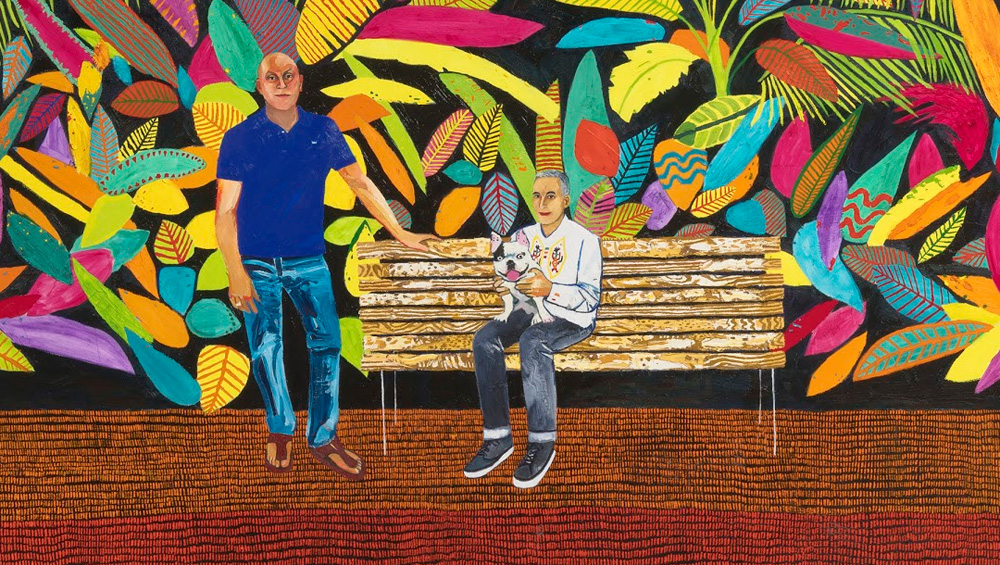
Raffi Kalenderian. Robert, Bob, and Seymour, 2019 (detail). Courtesy of the artist and Vielmetter Los Angeles. Photo: Robert Wedemeyer.
by ANNA McNAY
I first saw the work of Raffi Kalenderian (b1981, Los Angeles) in the Saatchi Gallery’s Painters’ Painters exhibition (2016-17), where his amazing blurring of subject and background, and use of stripes – with an almost unbelievably organic mastery – stood out and made him one of my latest artists to watch. Now, he is having his fourth solo exhibition at Vielmetter, Los Angeles – Memento Vivo– and so we took the opportunity to have a chat by email about what it is that excites him about his work, who and what he likes to paint and some of his influences, and it gave me the chance to glean a little insight into his practice.
Anna McNay: Where does the title of your current solo exhibition, Memento Vivo, come from? Literally it translates as “remember to live”. What do you intend to say with this?
Raffi Kalenderian: My friend Doug Harvey wrote an essay for my 2010 catalogue, Memoranda. The title was Memento Vivo: Raffi Kalenderian’s Radical Portraiture, and I loved it so much. I wanted to use it for this show, since the mood of the show is celebratory: I think of portraiture as an opportunity to show love. There are a lot of people in this show who have shown love to me over the years and this was a way to show love back. Also, while I was finishing making the work for the exhibition, “memento vivo” became a mantra I would say to myself. Sometimes, when I am painting, I have to fight self-doubt and make sure I am making decisions based on what is most exciting to me. When I said this mantra out loud in a weird accent, I would laugh, and it would help me to remember not to be afraid, not to worry, and to do the most exciting thing I could think of in that moment.
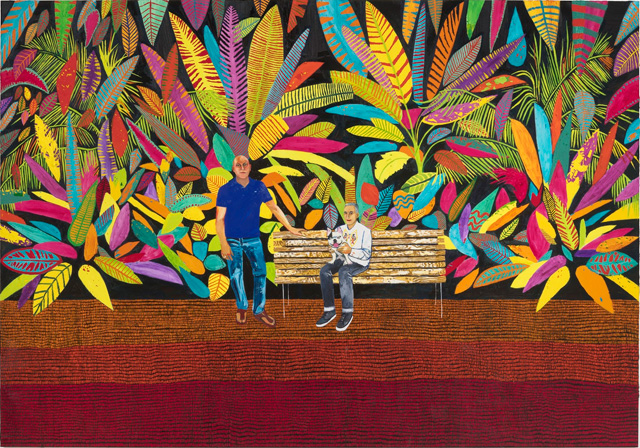
Raffi Kalenderian. Robert, Bob, and Seymour, 2019. Oil on canvas, 84 x 120 x 1.5 in (213.36 x 304.8 x 3.81 cm). Courtesy of the artist and Vielmetter Los Angeles. Photo: Robert Wedemeyer.
AMc: It seems to me as if the background of your portraits are as important, if not more so, than the sitters. Do you consider your works to be portraits merely of the sitters, or are they also portraits of the spaces in which the sitters are depicted? Or do these backgrounds contribute iconographically, through the objects you choose to include, to a picture of the sitter?
RK: I give myself permission to paint anything that is exciting to me, but I am most well known for my portraiture. I love painting my friends and people close to me, but it is also a great way to reach out to someone who I think is cool, but I wouldn’t necessarily have any other reason to hang out with. When I was an undergrad at UCLA, I remember wanting to hang out with some of the cooler grad students who made really exciting work. Asking them to sit for a portrait was a great way to spend time with them, find out about their life, ask for advice, etc. And, at the end of this conversation, you maybe get a really cool artwork out of it, and possibly even a friendship. The social aspect of portraiture is incredibly meaningful to me and probably the reason why I will always love portraiture and include it as a part my artistic practice.
One of the ways I think about portraiture is that the whole painting is the portrait: the room, the clothes, the plants. Whatever it is, I try to paint the whole painting with a certain intensity, which then bounces back into the figure in the portrait. Often the people in the paintings have a serene disposition, perhaps slightly melancholic, but the psychology is really in the vampiric animism of the wood grain, or the hot colours of the tropical plants. The clothes people choose to be painted in is one of my favourite things as well. I never paint nudes. I think what people wear offers such an interesting insight into who they are, and it is fun to take those details and use them as springboards for abstraction or distortion.
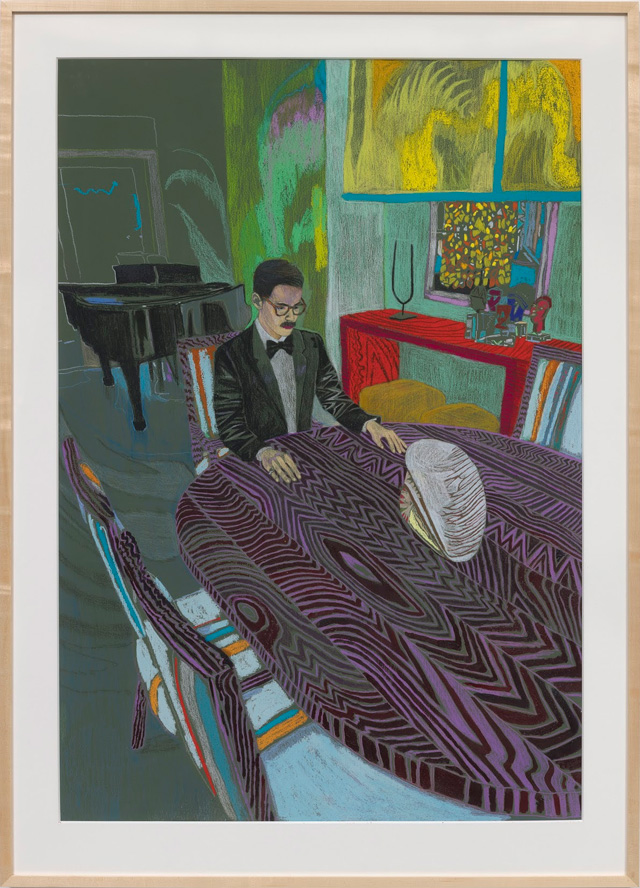
Raffi Kalenderian. Thomas, 2019. Oil, pastel, coloured pencil and acrylic on paper, 50.5 x 36 in (128.27 x 91.44 cm). Courtesy of the artist and Vielmetter Los Angeles. Photo: Robert Wedemeyer.
AMc: Do you work to commission? If so, does this alter the way you work?
RK: I have done maybe 10 commissions in my life. Most of them have been good experiences, but I am thinking about retiring from it if I can. Sometimes you have to pay rent and the right situation comes along, so it works out, but I am someone who naturally wants to make other people happy, and I have learned that this can get in the way of making a successful painting. Often, it makes me spend way more time on the work, so I end up losing money anyhow. But the ones that have gone well have been so beautiful and perfect, and I felt so happy to make the other people happy, and to be a part of this time in their life, and a real friendship came out of it. So I don’t know for sure.
AMc: Are your sitters always shown full length?
RK: No, not always, but I do enjoy showing a figure in a more active environment.
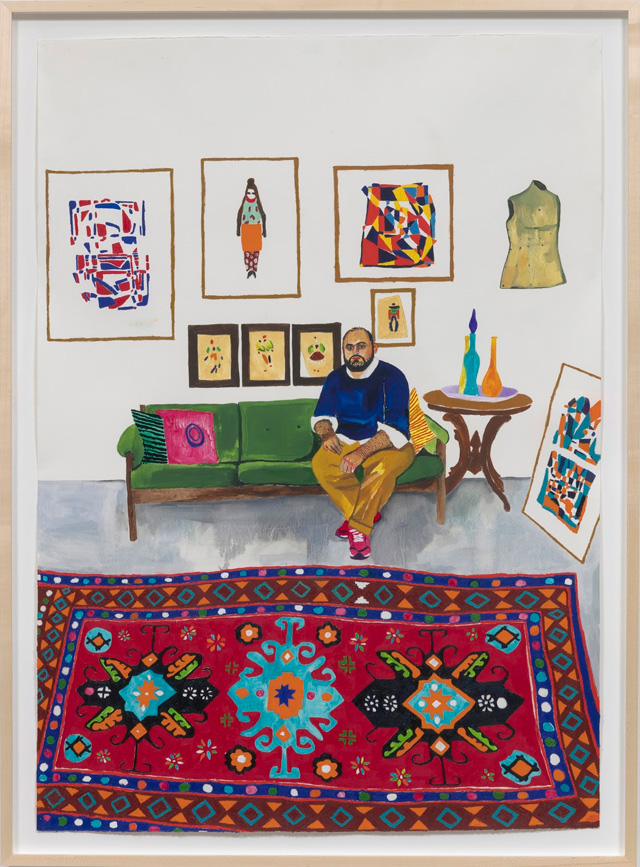
Raffi Kalenderian. Hormazd in his London Studio, 2019. Oil and pencil on paper, 50.5 x 36 in (128.27 x 91.44 cm). Courtesy of the artist and Vielmetter Los Angeles. Photo: Robert Wedemeyer.
AMc: Where are your paintings set? Do you go to the sitter’s home? Is the setting always somewhere that says something about them, or do you arbitrarily bring person and place together?
RK: Sometimes it is my studio, sometimes I go to the person’s house, or we go to a location I found and I take photos or make drawings. On a few occasions, one of my friends has posted a picture and I fell in love with it and could visualise how I would paint it, so I asked permission. By the time I am finished with my paintings, they hopefully have a timeless feel, but that could very easily be wishful thinking.
AMc: How important is it for you whether or not the sitter is making eye contact with the viewer – and thus also with you?
RK: It just depends on the work. I have a painting in this show of my brother reading in his bed, and it has a very different vibe from the ones where the figure is looking at the viewer. It just depends on the composition of the particular painting.
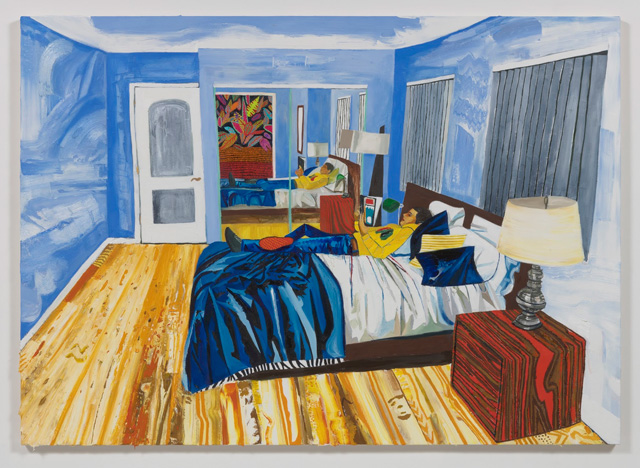
Raffi Kalenderian. Shanti Reading, 2019. Oil on canvas, 60.25 x 84 x 1.5 in (153.04 x 213.36 x 3.81 cm). Courtesy of the artist and Vielmetter Los Angeles. Photo: Robert Wedemeyer.
AMc: What is your process for making a painting? Are the colours true to life, or do you alter them to suit your composition and aesthetic? Tell me a little about your play on perspective, flattening the depth of field in the composition and bringing the background to the foreground and vice versa.
RK: I work in a variety of ways and the variation and experimentation is a huge part of what I love about making art. I paint and draw from life, and I also work from photos. Sometimes, I work in a way that is more realistic, but the only thing I care about is making an interesting painting. I love switching modes within a painting so that the logic in one section shifts completely by the time you jump to another part. Take the Thed Jewel painting, for example. Teddy is a friend of my friend Elliott Hundley, an amazing artist. I’ve known Teddy for more than 10 years, but not really well. He posted this picture of himself wearing a zebra-patterned shirt and bright red Nikes in his home. The picture is single-point perspective with woodgrain floors and windows and Teddy sitting in the middle, completely self-possessed. I fell in love with the image immediately and could visualise how I wanted to paint it – it already looked like one of my paintings! Teddy has been in a number of Elliott’s works, so I felt anxious about “muse stealing”. I asked Elliott if it was OK if I even asked Teddy. Elliott said yes. I asked Teddy, who also said yes, and so I went on my merry way.
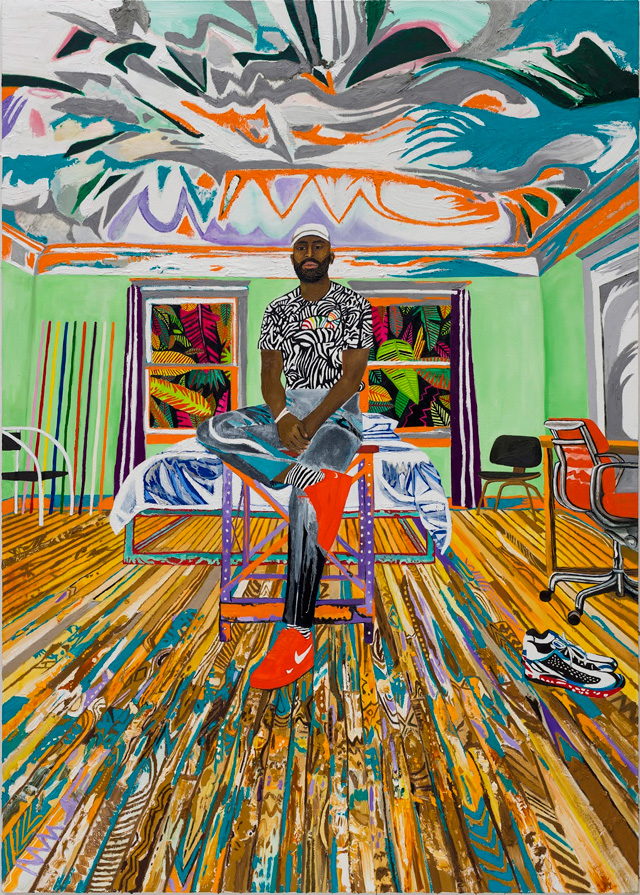
Raffi Kalenderian. Thed Jewel, 2019. Oil on canvas, 98 x 70 x 1.5 in (248.92 x 177.8 x 3.81 cm). Courtesy of the artist and Vielmetter Los Angeles. Photo: Robert Wedemeyer.
The original photo had this blinding white coming out of the windows, and so I was planning on painting a more atmospheric painting, with a blinding white coming out of the window and on to the floor and ceiling. Then I started putting colours like turquoise and orange and purple on to the floor and ceiling, and, when those colours dried, I was going to put a light layer of white over the ceiling parts and a light layer of ochre over the floor – that way it would create more seasoning, more complexity. But one of the main things I’ve learned about doing this, is that sitting in the chair during the process is so important, and I was sitting in the chair and looking at how cool the underpainting was, the ceiling was turning into an abstract storm, and the floor was woodgrain but then exploding with all of these new colours. It dawned on me that what was happening was even better than what I had planned, so I decided to abandon the original plan, and then I realised that if I was abandoning the original plan, I should put some psychedelic plants in the windows, a motif I was using in other parts of the show. Also, Teddy was wearing a zebra-patterned shirt and socks, and I had made a zebra painting in 2008, so the painting started to become full of this playful self-referentiality, not only to other paintings in the show, but to earlier paintings in my practice. The end result is not what the original plan was, but being able to recognise something working and evolving is a hugely exciting part of what I do.
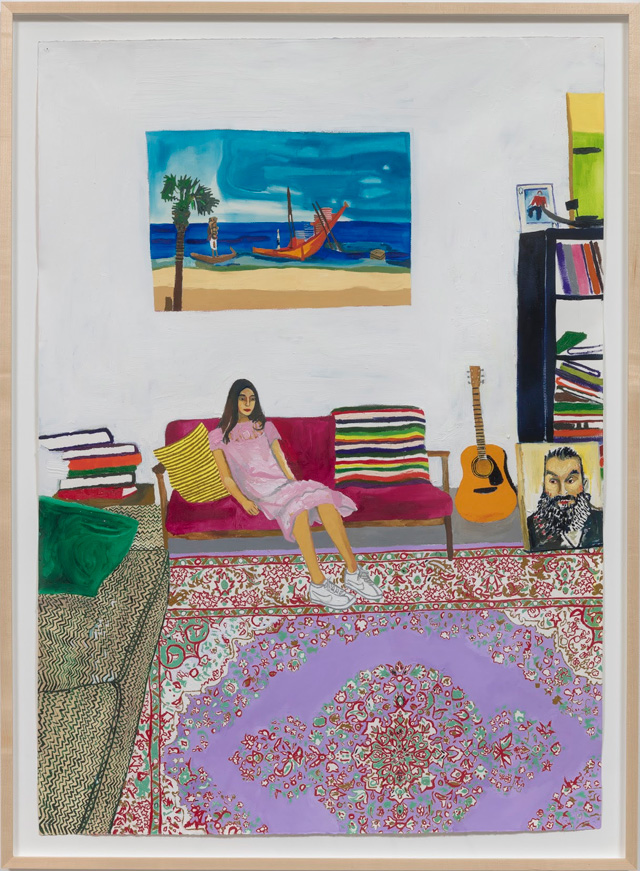
Raffi Kalenderian. Erika, 2019. Oil on paper, 50.5 x 36 in (128.27 x 91.44 cm). Courtesy of the artist and Vielmetter Los Angeles. Photo: Robert Wedemeyer.
AMc: As you have just mentioned, in your current exhibition at Vielmetter, plants play a significant role in the backgrounds. Is this something new for you? What do they symbolise?
RK: Last year, I showed a painting of some friends, a married couple, surrounded by tropical plants. The painting was hard to make, since I couldn’t figure out how to make the plants as fluorescent as I had envisioned in my mind’s eye. I kept working on it, then putting it away, then working on it, then putting it away. Then, finally, after 10 years, I figured out how to make the plants the way I wanted to, using a wax technique. I was so happy. The only thing was, by the time I finished, the couple had got divorced! But I wanted to use the technique as part of this show, Memento Vivo. I wanted some figures to exist in this plant-filled environment, and other paintings to have plants coming out of the windows, and for the show to be unified by this motif.
AMc: You paint in oil on canvas, but also work on paper. Which do you prefer?
RK: I use Arches paper, which you can paint on directly with oil, without priming. It’s amazing. I love working on paper like this, since there are certain moves you can do that are subtler and more delicate than on canvas. I love both, though, and, if you see the show in person, I think you can see how the different approaches to paint end up making sense together. My work really is something you have to see in person to understand. There are so many times when jpegs of it stress me out, since they don’t show what’s going on at all.
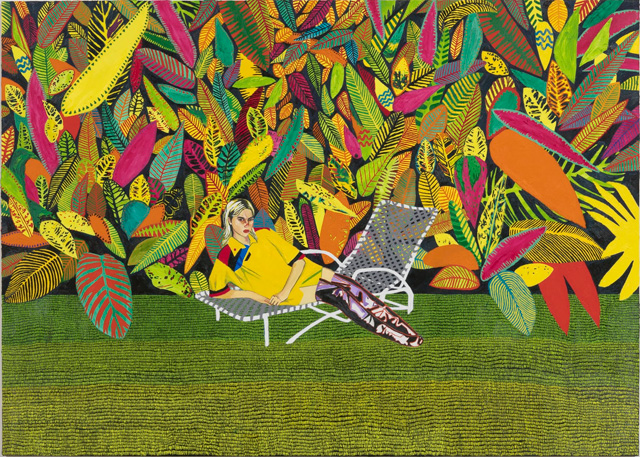
Raffi Kalenderian. Lauren, 2019. Oil on canvas, 70 x 98 x 1.25 in (177.8 x 248.92 x 3.18 cm). Courtesy of the artist and Vielmetter Los Angeles. Photo: Robert Wedemeyer.
AMc: How long does a work typically take you?
RK: My rule is: “If it looks great, stop.” If you have to make another one, go for it, but don’t ruin the one that already looks great. Some things look great in a day, others take 10 years. I probably need to learn to let go of some of those 10-year ones, but I get such satisfaction out of figuring out a problem like that. It’s like banging your head against a brick wall, but if you get through to the other side it feels so good.
AMc: Where do you derive your colour palette from?
RK: Intuition. Colour really is the most intuitive part of the process. I just know if it is working or not when I see it, and I can’t really explain why. I actually feel like I am not so great with colour, or I use it in an aggressive instead of a sophisticated way. But I think I’ve learned a lot from this show, and I am excited about where my work is going next, colourwise.
AMc: I’ve read that you are influenced by the quilts of American folk art, modernist abstraction and Mexican wall hangings. I feel sure you must also find inspiration in the works of Pierre Bonnard and Édouard Vuillard, for whom the patterned backgrounds and sitters/subjects equally seem to merge in a form of near abstraction? More contemporaneously, Alice Neel and David Hockney come to mind. Who are your key influences, past and present?
RK: I basically love anything with high-contrasting colours and patterns – all the things you listed, plus Coogi sweaters, television static, or even the pattern on croton plants. I really love Bonnard and Vuillard, big time. When I was a student at UCLA, I had a lot of amazing professors, but Laura Owens was one of the most important teachers I had, mainly because she was one of the first who made me feel I could have a career in the arts if I wanted to. She was also the one who introduced me to the work of Alice Neel and David Hockney. I was immediately in love. Even now, I think of Hockney and Neel as my “art parents”.
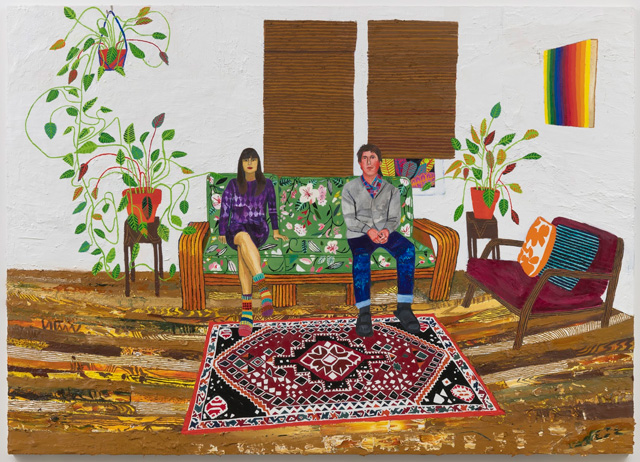
Raffi Kalenderian. Rochele and Nick, 2019. Oil on canvas
70 x 98 x 1.5 in (177.8 x 248.92 x 3.81 cm). Courtesy of the artist and Vielmetter Los Angeles. Photo: Robert Wedemeyer.
AMc: Who do you rate as a contemporary painter?
RK: This could easily turn into a list of artists I love, and that could go on all day. I will, however, say that, even though I would never consider myself as a contemporary, I am so happy and proud to show at the same gallery as Nicole Eisenman and Amy Sillman. Also, I have been friends with the artists Elliott Hundley and Jonas Wood for about 18 years, since before any of us had art careers. I love both these men, love their art, and am so grateful for the many conversations over the years that have hugely influenced my thinking about art and life.
AMc: There is a sense of acute claustrophobia in many of your compositions. Is this deliberate?
RK: Ummmm, claustrophobia sounds really stressful, and that is the opposite of what I am going for. I hope the density of the paintings is seen as an asset, something that is about my excitement for including all of this visual information. Hopefully, it will inspire some level of excitement in the viewer, but I also know I can’t control how people see the work. One thing that has been helpful to me in terms of making these densely painted plant paintings, is that I have been putting the brightest colours next to each other and they all merge to create a fluorescent grey. That is the kind of interesting visual discovery that will help me in the future as I try to use colour in a more sophisticated way. Hopefully the people who feel claustrophobia will forgive me!
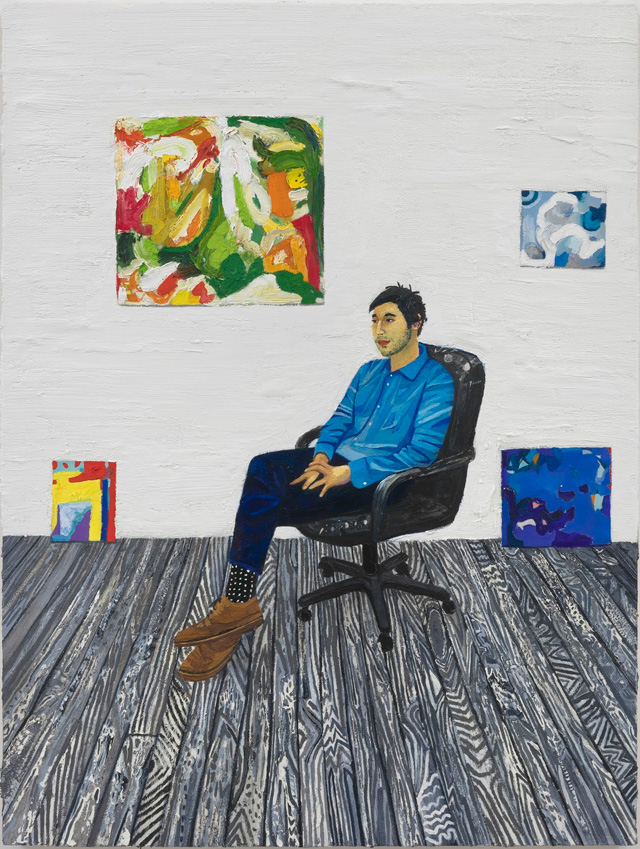
Raffi Kalenderian. Eric Palgon in the studio, 2019. Oil on canvas, 48 x 36 x 2 in (121.92 x 91.44 x 5.08 cm). Courtesy of the artist and Vielmetter Los Angeles. Photo: Robert Wedemeyer.
AMc: What are you most trying to capture in a work? A physical likeness? A psychological one? A mood? Simply something aesthetically intriguing?
RK: My only goal is to make an interesting painting. I made a self-portrait a few years ago where the light was coming in through my curtains, and it was making the entire room a greenish colour. I had figured out that if I used a heavy paint, then let it dry, I could glaze the whole work with this green colour, which gave the entire painting a rich seasoning. Before starting that painting, I knew that I wanted to make a painting about the sunshine in Los Angeles. Everyone always talks about the sunshine in LA like it is so great, and it is, but sometimes it can give me an intense feeling of dread. I wanted to make a painting about LA’s sunshine that was more psychological. I used to be much more nocturnal, and, at the time I made this painting, I was in a pattern where I would paint all night and then go to sleep at 10am, so the light coming in when I was so tired was causing anxiety. Anyway, I knew what the mood was for the painting, and, from there, that led me to come up with some techniques that could properly describe the psychology of the room. I don’t know exactly what a painting will look like when I start, but the process of figuring it out is what makes it exciting for me.
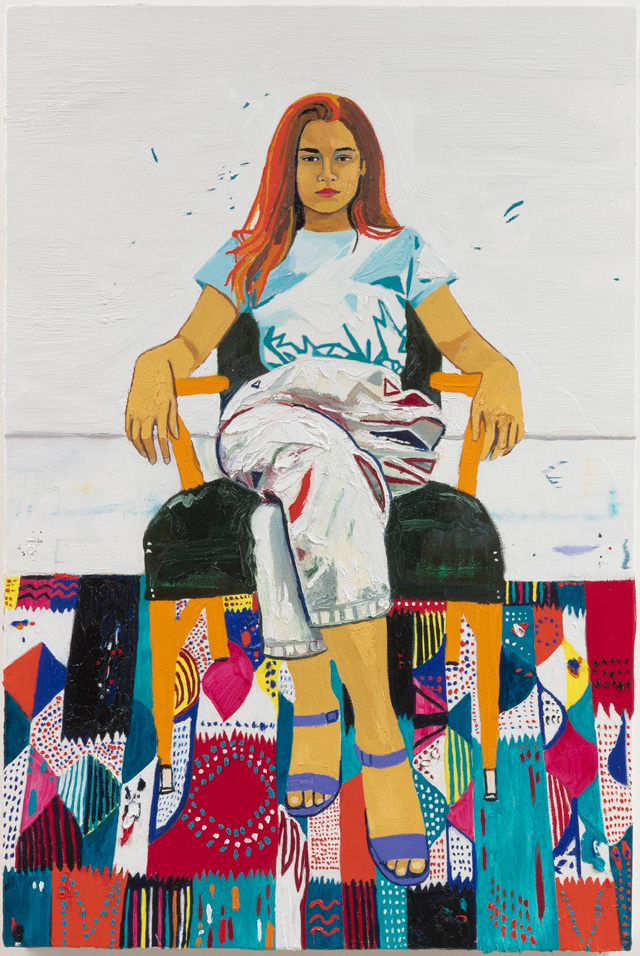
Raffi Kalenderian. Stephanie, 2019. Oil on canvas,
36 x 24 in (91.44 x 60.96 cm). Courtesy of the artist and Vielmetter Los Angeles. Photo: Robert Wedemeyer.
AMc: Is there ever any element of narrative in your work?
RK: When I was younger, I made these overt, confessional narrative paintings that eventually I found to be hugely embarrassing. One of the lessons I’ve learned over the years is to trust the viewer, to make work for the highest audience, and to have faith that everything I wish to be communicated will be communicated by the way I paint it.
AMc: How much of your practice is about composition, how much about capturing an image of reality, and how much about the materiality of the paint and canvas/paper themselves?
RK: I think this is a good question, but I also find it impossible to answer. It is hard for me to break these things down to percentages, it really just depends on the piece and what I am thinking of at the time I am making it. For this show, I was finishing the painting of Rochele and Nick, and I was painting all of these little marks in the woodgrain. Something wasn’t working and I felt I needed to do something wild, so I got the palette knife out and did some wild moves over a lot of the woodgrain patterns that I had painted. The end result was a mixture of the patterns from before, along with this more intense impasto paint that added a performative aspect to the painting. It really underscored the materiality. There is this momentum with the woodgrain that changes the gravity of the room, so the rug looks like it is bending towards the viewer. Everything just unfolds in the studio. I try to be as open as I can. I know I have a bunch of different painting moves in my arsenal, so it’s all about trusting that I will find the answers.
• Raffi Kalenderian: Memento Vivo is at Vielmetter, Los Angeles, until 29 June 2019.